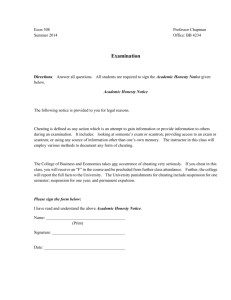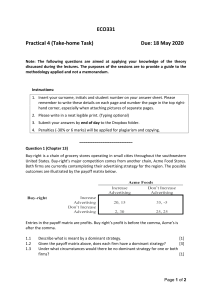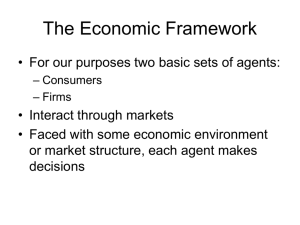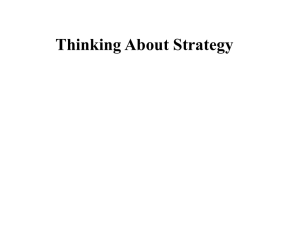ppp
advertisement
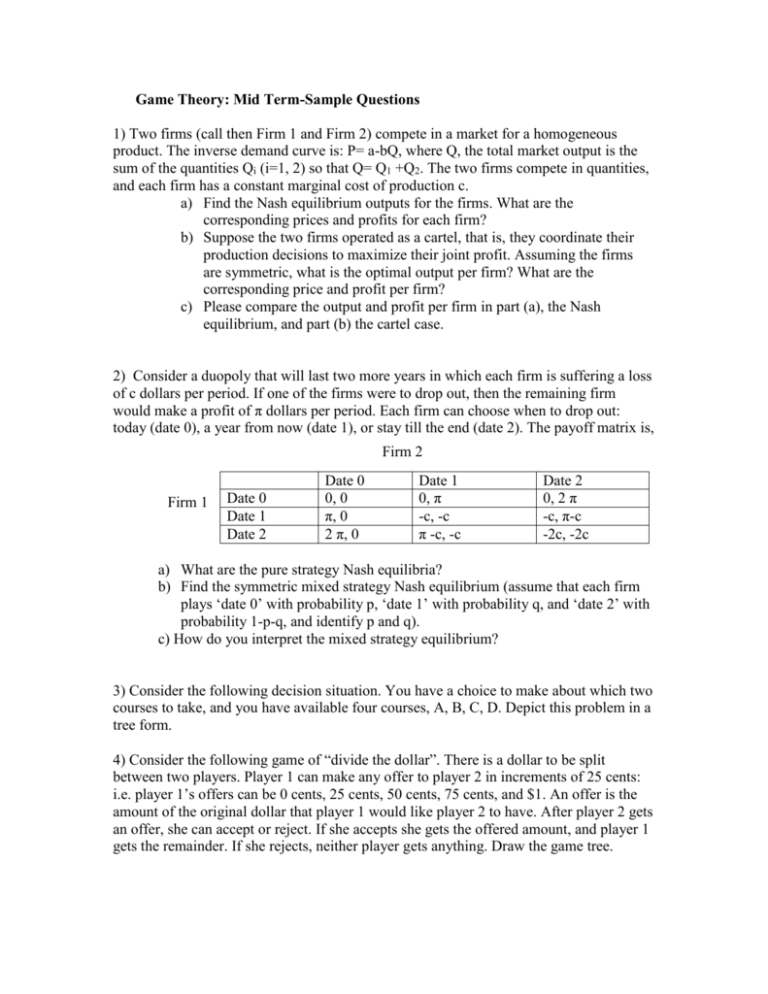
Game Theory: Mid Term-Sample Questions 1) Two firms (call then Firm 1 and Firm 2) compete in a market for a homogeneous product. The inverse demand curve is: P= a-bQ, where Q, the total market output is the sum of the quantities Qi (i=1, 2) so that Q= Q1 +Q2. The two firms compete in quantities, and each firm has a constant marginal cost of production c. a) Find the Nash equilibrium outputs for the firms. What are the corresponding prices and profits for each firm? b) Suppose the two firms operated as a cartel, that is, they coordinate their production decisions to maximize their joint profit. Assuming the firms are symmetric, what is the optimal output per firm? What are the corresponding price and profit per firm? c) Please compare the output and profit per firm in part (a), the Nash equilibrium, and part (b) the cartel case. 2) Consider a duopoly that will last two more years in which each firm is suffering a loss of c dollars per period. If one of the firms were to drop out, then the remaining firm would make a profit of π dollars per period. Each firm can choose when to drop out: today (date 0), a year from now (date 1), or stay till the end (date 2). The payoff matrix is, Firm 2 Firm 1 Date 0 Date 1 Date 2 Date 0 0, 0 π, 0 2 π, 0 Date 1 0, π -c, -c π -c, -c Date 2 0, 2 π -c, π-c -2c, -2c a) What are the pure strategy Nash equilibria? b) Find the symmetric mixed strategy Nash equilibrium (assume that each firm plays ‘date 0’ with probability p, ‘date 1’ with probability q, and ‘date 2’ with probability 1-p-q, and identify p and q). c) How do you interpret the mixed strategy equilibrium? 3) Consider the following decision situation. You have a choice to make about which two courses to take, and you have available four courses, A, B, C, D. Depict this problem in a tree form. 4) Consider the following game of “divide the dollar”. There is a dollar to be split between two players. Player 1 can make any offer to player 2 in increments of 25 cents: i.e. player 1’s offers can be 0 cents, 25 cents, 50 cents, 75 cents, and $1. An offer is the amount of the original dollar that player 1 would like player 2 to have. After player 2 gets an offer, she can accept or reject. If she accepts she gets the offered amount, and player 1 gets the remainder. If she rejects, neither player gets anything. Draw the game tree. 5) Consider the following group project example. Three students-Andrew, Dice and claysimultaneously work together on a problem set. The instructor had asked them to submit a joint solution. Each student can work hard (H) or goof off (G). if all three work hard, they will get an A; if at least two students work hard, they will get a B; if only one student works hard, they will get a C; and if nobody works hard, they will get an F. The payoff function is π and depends on the amount of work. For example, the payoff to H and a grade of B is π(H, B). Write out the extensive form.







